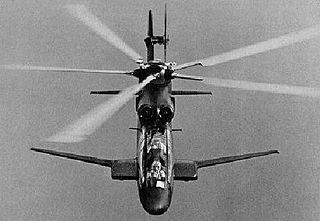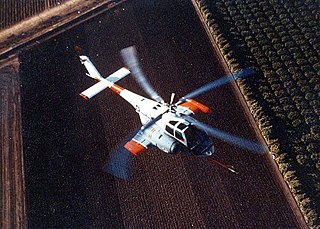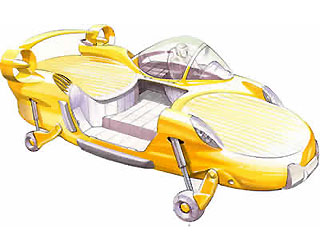
The Piasecki X-49 "SpeedHawk" is an American four-bladed, twin-engined experimental high-speed compound helicopter developed by Piasecki Aircraft. The X-49A is based on the airframe of a Sikorsky YSH-60F Seahawk, but utilizes Piasecki's proprietary vectored thrust ducted propeller (VTDP) design and includes the addition of lifting wings. The concept of the experimental program was to apply the VTDP technology to a production military helicopter to determine any benefit gained through increases in performance or useful load.

The Kamov Ka-26 is a Soviet light utility helicopter with co-axial rotors.

The Curtiss-Wright X-19, company designation Model 200, was an American experimental tiltrotor aircraft of the early 1960s. It was noteworthy for being the last aircraft of any kind manufactured by Curtiss-Wright.

The Sikorsky S-67 Blackhawk was a private-venture, prototype attack helicopter built in 1970 with Sikorsky Aircraft research and development (R&D) funds. A tandem, two-seat aircraft designed around the dynamic drive and rotor systems of the Sikorsky S-61, it was designed to serve as an attack helicopter or to transport up to eight troops into combat.

The Lockheed XH-51 was an American single-engine experimental helicopter designed by Lockheed Aircraft, utilizing a rigid rotor and retractable skid landing gear. The XH-51 was selected as the test vehicle for a joint research program conducted by the United States Army and United States Navy to explore rigid rotor technology.

The Bell 214 is a medium-lift helicopter derived from Bell Helicopter's ubiquitous UH-1 Huey series. The Bell 214ST shares the same model number, but is a larger, much-modified twin-engine derivative.

The Sikorsky S-69 is an American experimental co-axial compound helicopter developed by Sikorsky Aircraft as the demonstrator of the Advancing Blade Concept (ABC) under United States Army and NASA funding.

The Urban Aeronautics X-Hawk is a proposed flying car designed by Rafi Yoeli in Yavne, Israel, being built by Metro Skyways Ltd., a subsidiary of Yoeli's privately held company, Urban Aeronautics. The firm claims to have flown the car to a height of 90 cm (3 ft), and that greater heights are possible. The X-Hawk and its smaller unmanned version, the Tactical Robotics Cormorant, would be used in search and rescue operations where a helicopter would be useless, or at least very dangerous, such as evacuating people from the upper stories of burning buildings, or delivering and extracting police and soldiers while very close to structures, narrow streets, and confined spaces, with a projected size similar to that of a large van.

The Agusta A.101 was a large prototype transport helicopter developed in Italy during the 1960s. Despite prospective orders from the Italian armed forces, no buyers emerged and the project was abandoned in 1971.

The Bell HSL was an American 1950s anti-submarine warfare (ASW) helicopter built by the Bell Helicopter company, the only tandem rotor type designed by Bell.

The Bell 400 TwinRanger was a prototype four-bladed, twin-engine civil helicopter developed by Bell Helicopter in the 1980s. Both the TwinRanger and another planned version, the Bell 440, were attempts to market a twin-engine development of the Model 206L LongRanger. The Bell 400A was a planned single-engine version of the 400. TwinRanger, however development was canceled when Bell could not acquire enough orders for production. The TwinRanger name was later used for a twin-engine version of the LongRanger produced from 1994 to 1997.

The Westland 30 is a British medium helicopter based on the Westland Lynx military helicopter. Although Westland Helicopters foresaw a market for the type in VIP, passenger and cargo transport, and off-shore support operations, production remained limited, ending in 1987 after 41 aircraft had been built.

The Bell 214ST is a medium-lift, twin-engine helicopter descended from Bell Helicopter's ubiquitous UH-1 Huey series. Though it shares a type number with the somewhat-related Bell 214, the 214ST is larger and of quite different appearance.

The Boeing Model 360 is an American experimental medium-lift tandem rotor cargo helicopter developed privately by Boeing to demonstrate advanced helicopter technology. The aircraft was intended as a technology demonstrator, with no plans to put the type into production, and many of its design features were carried onto other programs including the RAH-66 Comanche and V-22 Osprey. The sole prototype has been preserved and is a static exhibit at the American Helicopter Museum in West Chester, Pennsylvania.

The Sikorsky XH-39, developed by Sikorsky Aircraft in 1954, was the U.S. Army's first turbine-powered helicopter. It was fast and innovative, but ultimately rejected by the United States Army in favor of the Bell UH-1 Iroquois.
The Kamov Ka-126 is a Soviet light utility helicopter with co-axial rotors. Evolved from Ka-26 with engine pods removed from stub wings, fitted with one TVO-100 turboshaft engine positioned on top of fuselage, modified rotor blades, new fuel system.

The Piasecki H-16 Transporter was a tandem-rotor transport or rescue helicopter designed by Frank Piasecki and built by Piasecki Helicopter. The prototypes were evaluated by the United States Air Force and Army, but the crash of the second test aircraft led to cancelling the project.

The Agusta A.105 was an Italian rotorcraft designed by Agusta. It was never developed beyond the prototype stage.
The Nord 1750 Norelfe was a 1950s French three-seat helicopter built by Nord Aviation and designed by Jean Cantinieau.
The Harbin Z-20 is a medium-lift utility helicopter produced by the Harbin Aircraft Industry Group (HAIG). It was first flown on 23 December 2013 and has a maximum takeoff weight in the range of 10 tonnes (22,000 lb). The Z-20 can operate from locations above 4,000 m (13,000 ft) in altitude as well as from the Liaoning aircraft carrier. It is regarded to be comparable in performance to the US-made Sikorsky UH-60 Black Hawk helicopter, which civilian variant Sikorsky S-70C-2 has been used by the People's Liberation Army since 1984.


















